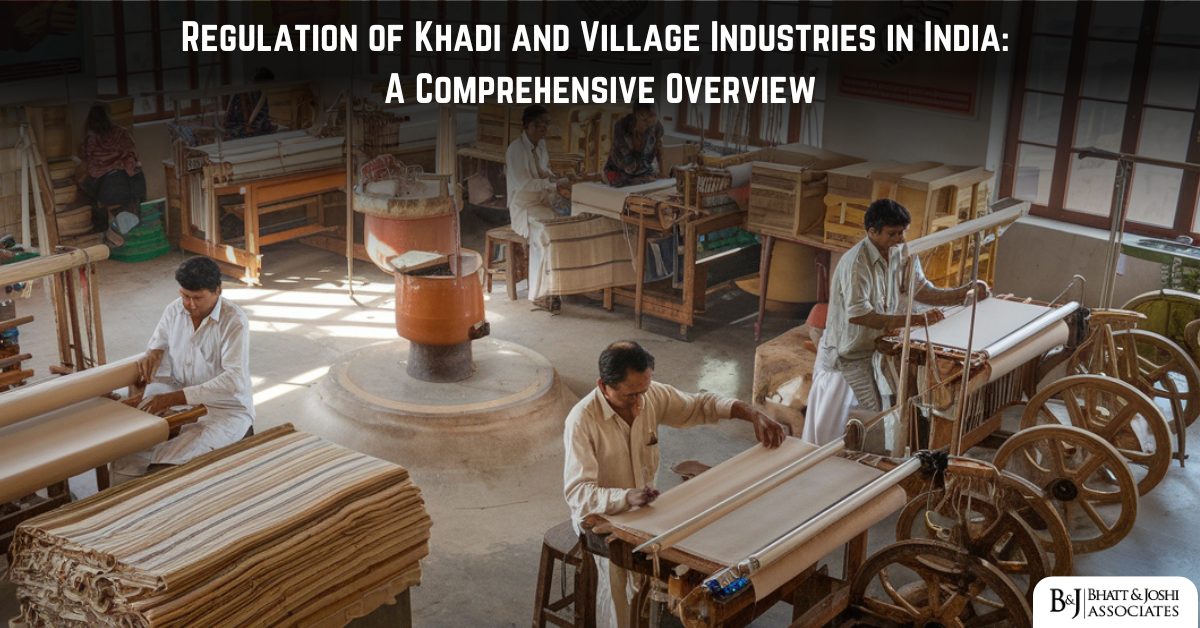Introduction
Khadi and Village Industries occupy a unique position in India’s economic and cultural landscape. Rooted in the country’s struggle for independence and championed by Mahatma Gandhi, these industries have evolved from symbols of self-reliance to vital contributors to rural employment and sustainable development. This document provides an in-depth exploration of the regulatory framework, laws, and significant case laws governing the Khadi and Village Industries sector in India.
Regulatory Body: Khadi and Village Industries Commission (KVIC)
The primary regulatory authority for the Khadi and Village Industries sector is the Khadi and Village Industries Commission (KVIC), established under the Khadi and Village Industries Commission Act, 1956. This statutory body operates under the Ministry of Micro, Small and Medium Enterprises, Government of India. The KVIC serves as the planning, promoting, and facilitating agency for the development of khadi and village industries in rural areas, in coordination with other agencies engaged in rural development.
The KVIC’s mandate extends beyond mere regulation. It is tasked with promoting the sale and marketing of khadi and products of village industries, encouraging and promoting research in the production techniques employed in the khadi and village industries sector, providing training in khadi and village industries, and building up reserves of raw materials for supply to producers. The Commission also works to encourage cooperative efforts among the artisans and to arrange for the supply of raw materials, tools, and equipment to producers in the khadi and village industries sector.
Legal Framework Governing Khadi and Village Industries in India
The legal framework governing Khadi and Village Industries in India is primarily centered around the Khadi and Village Industries Commission Act, 1956, which has been amended several times to adapt to changing economic realities and development priorities.
Khadi and Village Industries Commission Act, 1956
This foundational legislation provides the legal basis for the establishment and functioning of the KVIC. The Act defines the composition, powers, and functions of the Commission. Section 15 of the Act outlines the functions of the KVIC in detail:
“It shall be the duty of the Commission to promote the development of khadi and village industries and for that purpose the Commission may undertake the following measures, namely:— (a) promote the sale and marketing of khadi or products of village industries or handicrafts; (b) provide financial assistance to institutions or persons engaged in the development and operation of khadi or village industries; (c) undertake directly or through other agencies studies concerning the problems of khadi or village industries; (d) provide training in matters related to the production of khadi or village industries; (e) encourage and promote research in the production techniques employed in the khadi and village industries sector; (f) provide for the quality marking of the products of khadi or village industries; (g) establish and maintain separate organizations for the purpose of carrying out any or all of the above matters; (h) carry out any other matters incidental to the above.”
The Act also empowers the KVIC to declare any industry as a ‘village industry’, thus bringing it under the purview of the Commission’s developmental and regulatory activities.
Khadi Mark Regulations, 2013
These regulations, notified under the KVIC Act, aim to protect the authenticity of khadi products and prevent the sale of fake khadi. The regulations make it mandatory for all khadi institutions and producers to obtain ‘Khadi Mark’ certification from the KVIC. The regulations state:
“No textile shall be sold or otherwise traded by any person or institution as khadi or any gram udyog product, in any form or manner without obtaining a Khadi Mark Certificate from the KVIC and affixing the Khadi Mark Tag on each such product.”
This regulatory measure seeks to safeguard the interests of genuine khadi producers and maintain consumer trust in khadi products.
Sarvodaya Development Scheme
While not a law in the strict sense, this scheme forms an integral part of the regulatory framework for khadi and village industries. It provides financial assistance to khadi institutions for the development of infrastructure, modernization of sales outlets, and training of artisans. The scheme’s guidelines state:
“The primary objective of the Sarvodaya Development Scheme is to strengthen the infrastructure of existing weak khadi institutions and to create new infrastructure for khadi production and sales.”
Case Laws
Several significant court judgments have shaped the interpretation and implementation of regulations affecting the Khadi and Village Industries sector in India.
Khadi and Village Industries Commission v. Khatau Makanji Spinning and Weaving Co. Ltd. (1998)
This landmark case dealt with the protection of the ‘Khadi’ trademark. The Supreme Court of India emphasized the unique status of khadi, observing:
“The word ‘Khadi’ is not merely a generic name. It represents the ideals of Mahatma Gandhi and symbolizes the spirit of self-reliance and economic independence. The KVIC has the exclusive right to use the word ‘Khadi’ and its variations, and this right must be protected to prevent misleading of consumers and dilution of the Khadi brand.”
This judgment reinforced the KVIC’s authority to regulate the use of the term ‘Khadi’ and protect its unique identity.
Khadi Gramodaya Sangh v. Khadi and Village Industries Commission (2005)
This case dealt with the KVIC’s power to regulate khadi institutions. The Delhi High Court ruled:
“The KVIC, as the statutory body entrusted with the development of khadi and village industries, has the authority to set standards and guidelines for khadi institutions. This includes the power to certify institutions and withdraw certification if they fail to meet the prescribed standards. Such regulatory powers are essential for maintaining the quality and authenticity of khadi products.”
This judgment affirmed the KVIC’s regulatory authority over khadi institutions and its role in maintaining standards in the sector.
Khadi and Village Industries Commission v. Brijbhushan (2017)
In this case, the Bombay High Court dealt with the issue of trademark infringement in the context of khadi products. The court observed:
“The use of the term ‘Khadi’ or any deceptively similar mark by unauthorized entities not only infringes upon the KVIC’s trademark rights but also undermines the very essence of khadi as a symbol of India’s self-reliance and rural development. The courts must take a strict view of such infringements to protect the integrity of the khadi sector.”
This judgment strengthened the legal protection for the ‘Khadi’ trademark and emphasized the courts’ role in safeguarding the khadi sector’s interests.
Recent Developments and Initiatives
The regulatory landscape of the Khadi and Village Industries sector continues to evolve, with several recent initiatives aimed at addressing contemporary challenges and opportunities.
The ‘Khadi India’ brand has been repositioned to appeal to a younger, urban demographic while maintaining its traditional values. This initiative includes modernizing khadi production processes, improving product design, and expanding the range of khadi products.
The KVIC has launched the ‘Khadi e-Portal’, an e-commerce platform to expand the market reach of khadi and village industry products. This digital initiative aims to connect khadi institutions and artisans directly with consumers across India and globally.
The ‘Honey Mission’ is another significant initiative by the KVIC, aimed at creating employment for rural and tribal populations through beekeeping. This program not only provides livelihood opportunities but also contributes to environmental conservation and sustainable agriculture.
The KVIC has also been actively promoting the use of solar charkhas (spinning wheels) to modernize khadi production while maintaining its eco-friendly nature. The ‘Solar Charkha Mission’ aims to introduce solar-powered charkhas in khadi institutions across the country, enhancing productivity and reducing drudgery for spinners.
Challenges and Future Outlook for Khadi and Village Industries in India
Despite its rich heritage and government support, the Khadi and Village Industries sector faces several challenges. The sector struggles with issues of quality consistency, especially given the decentralized nature of production. There’s also a need for continuous innovation in product design and production techniques to meet changing consumer preferences while maintaining the essence of khadi.
Marketing remains a significant challenge, particularly in competing with mass-produced goods. While the ‘Khadi India’ brand repositioning has shown promise, there’s a need for sustained efforts to build brand equity and expand market share, both domestically and internationally.
The sector also faces challenges in attracting and retaining skilled artisans, as younger generations often prefer other employment opportunities. Addressing this requires not just skill development initiatives but also efforts to improve the overall attractiveness of careers in the khadi and village industries sector.
Looking ahead, the regulatory framework for the Khadi and Village Industries sector is likely to evolve in response to these challenges. Future regulatory efforts may focus on strengthening quality control mechanisms, possibly through the use of technology. There may also be a push for more stringent enforcement of the Khadi Mark regulations to protect the authenticity of khadi products.
The integration of sustainable practices and technologies in khadi and village industries is likely to be another area of focus. This could include regulations and incentives for adopting eco-friendly production processes and using organic materials.
As e-commerce continues to grow, we may see more comprehensive regulations governing the online sale of khadi and village industry products. This could include guidelines for ensuring the authenticity of products sold online and measures to protect the interests of artisans in the digital marketplace.
Conclusion
The regulatory framework governing India’s Khadi and Village Industries sector reflects a delicate balance between preserving traditional values and adapting to modern economic realities. From the foundational Khadi and Village Industries Commission Act to recent initiatives like the Khadi e-Portal, the legal and policy landscape demonstrates a commitment to nurturing this unique sector.
As India continues to navigate the challenges of globalization and changing consumer preferences, the regulatory approach to the Khadi and Village Industries sector will likely need further refinement. The key lies in maintaining the essence of khadi as a symbol of self-reliance and sustainable development while embracing innovations that can enhance its appeal and economic viability.
The future of Khadi and Village Industries regulation in India will depend on the effective implementation of existing laws, continuous dialogue between stakeholders, and a willingness to adapt policies to address emerging challenges. By fostering an environment that values both tradition and innovation, India can ensure that its Khadi and Village Industries sector not only survives but thrives in the 21st century, continuing to serve as a beacon of sustainable and inclusive economic development.














